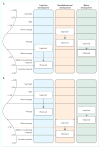Developmental brain dysfunction: revival and expansion of old concepts based on new genetic evidence
- PMID: 23518333
- PMCID: PMC4013791
- DOI: 10.1016/S1474-4422(13)70011-5
Developmental brain dysfunction: revival and expansion of old concepts based on new genetic evidence
Erratum in
- Lancet Neurol. 2013 May;12(5):423
Abstract
Neurodevelopmental disorders can be caused by many different genetic abnormalities that are individually rare but collectively common. Specific genetic causes, including certain copy number variants and single-gene mutations, are shared among disorders that are thought to be clinically distinct. This evidence of variability in the clinical manifestations of individual genetic variants and sharing of genetic causes among clinically distinct brain disorders is consistent with the concept of developmental brain dysfunction, a term we use to describe the abnormal brain function underlying a group of neurodevelopmental and neuropsychiatric disorders and to encompass a subset of various clinical diagnoses. Although many pathogenic genetic variants are currently thought to be variably penetrant, we hypothesise that when disorders encompassed by developmental brain dysfunction are considered as a group, the penetrance will approach 100%. The penetrance is also predicted to approach 100% when the phenotype being considered is a specific trait, such as intelligence or autistic-like social impairment, and the trait could be assessed using a continuous, quantitative measure to compare probands with non-carrier family members rather than a qualitative, dichotomous trait and comparing probands with the healthy population.
Copyright © 2013 Elsevier Ltd. All rights reserved.
Conflict of interest statement
We declare that we have no conflicts of interest.
Figures



References
-
- American Psychiatric Association. [accessed Sept 17, 2012];DSM-5 Development. 2012 http://www.dsm5.org.
-
- Johnson MR, Shorvon SD. Heredity in epilepsy: neurodevelopment, comorbidity, and the neurological trait. Epilepsy Behav. 2011;22:421–27. - PubMed
-
- Myers SM. Diagnosis of developmental disabilities. In: Batshaw ML, Lotrecchiano GR, Roizen NJ, editors. Children with disabilities. 7. Baltimore: Paul H. Brookes Publishing Co; 2013. pp. 243–66.
Publication types
MeSH terms
Grants and funding
LinkOut - more resources
Full Text Sources
Other Literature Sources
Medical

